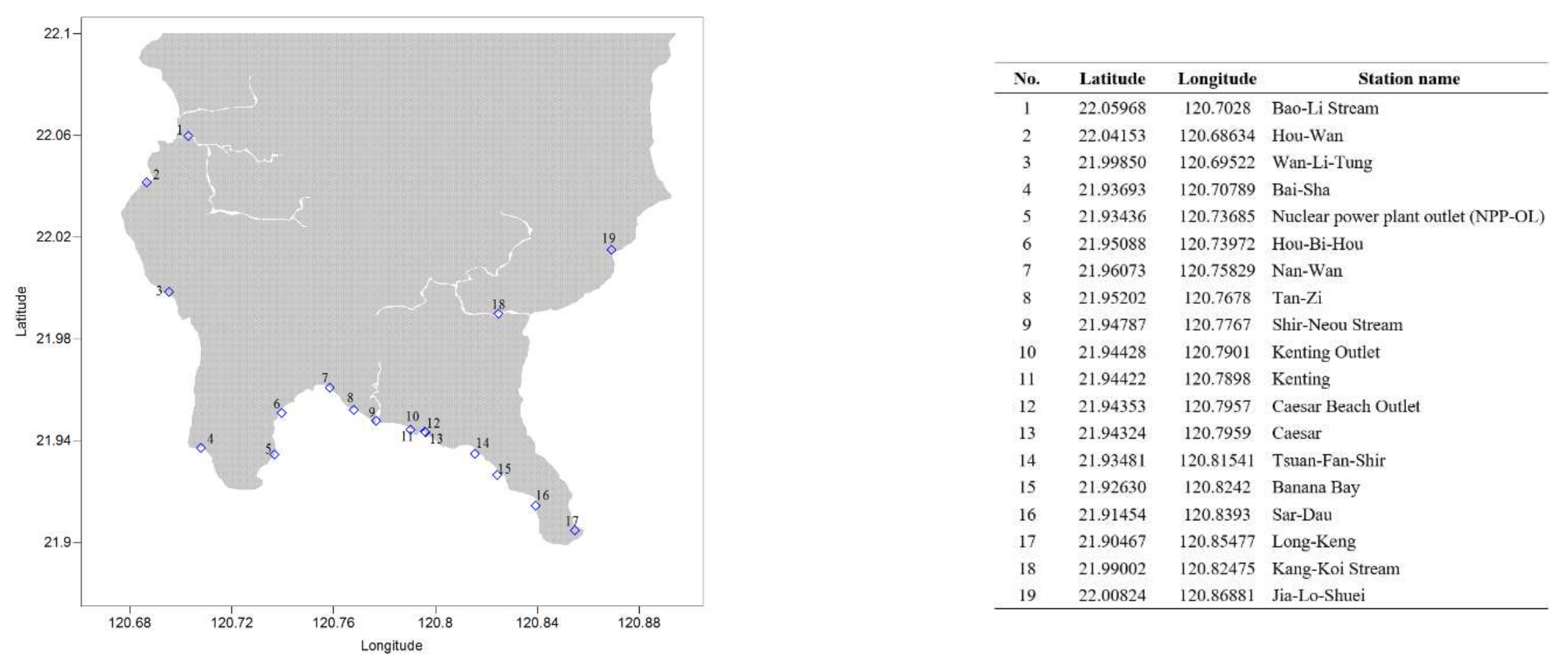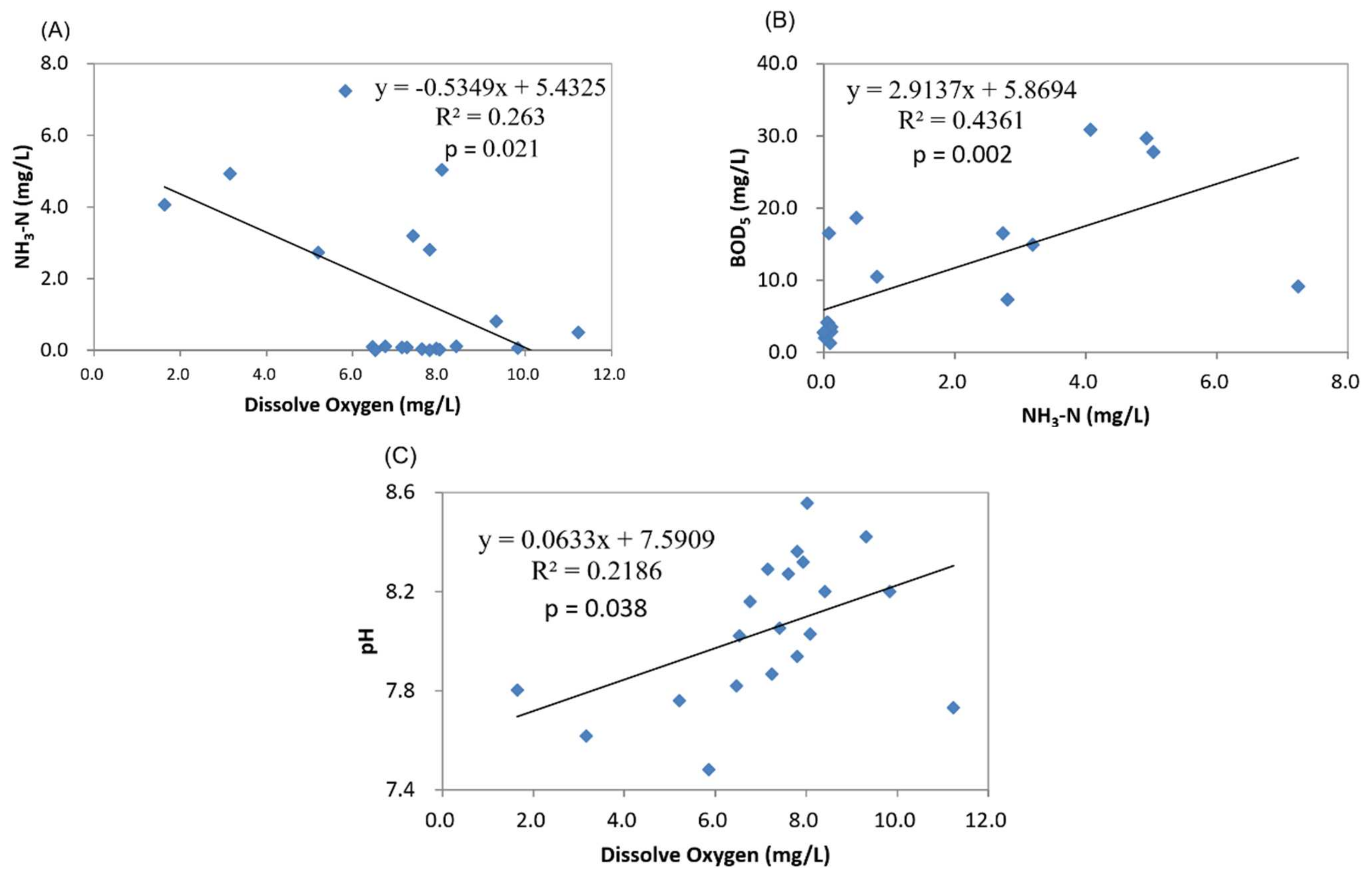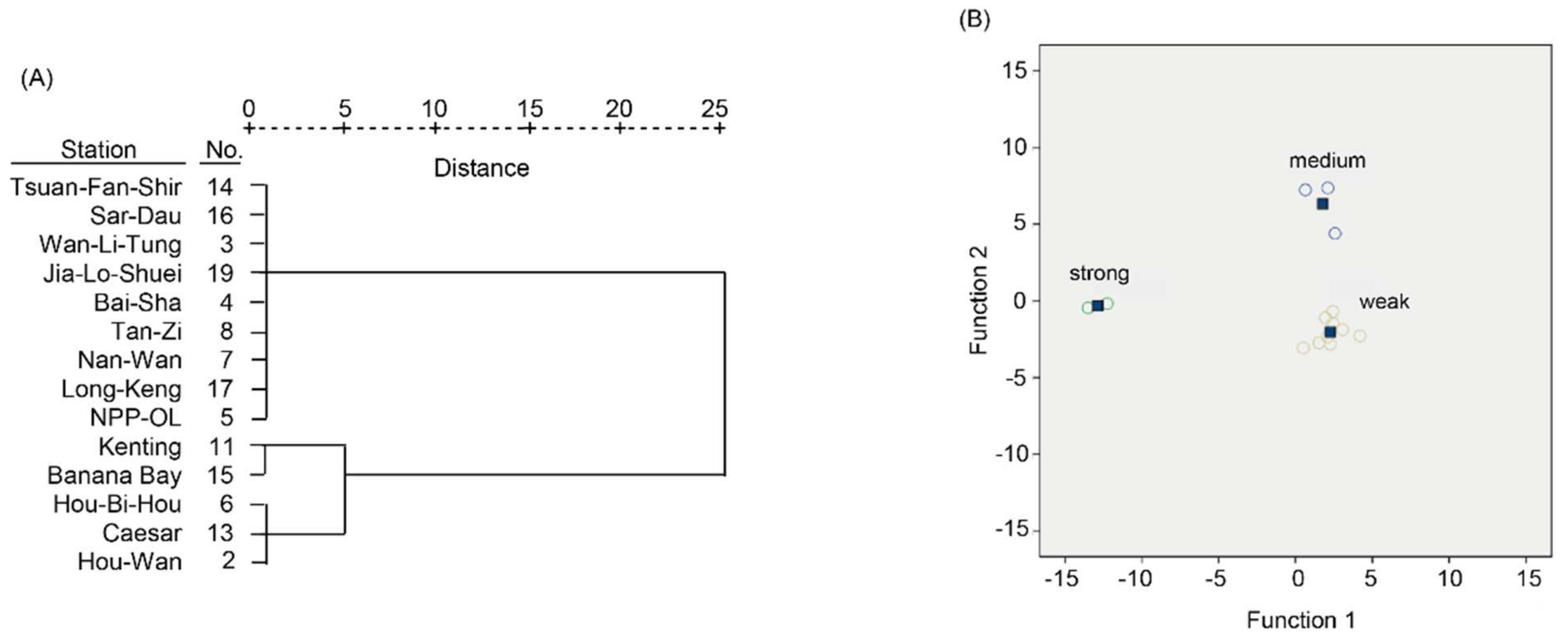The Key Impact on Water Quality of Coral Reefs in Kenting National Park
Abstract
:1. Introduction
2. Materials and Methods
3. Results and Discussion
4. Conclusions
Supplementary Materials
Author Contributions
Funding
Data Availability Statement
Acknowledgments
Conflicts of Interest
References
- Meng, P.J.; Chung, K.N.; Chen, J.P.; Chen, M.H.; Liu, M.C.; Chang, Y.C.; Fan, T.Y.; Lin, H.J.; Liu, B.R.; Chang, C.M.; et al. Long-term ecological monitoring and studies of human activities on the marine ecosystem of Kenting National Park. Bull. Natl. Park 2007, 17, 89–111. [Google Scholar]
- Meng, P.J.; Chung, K.N.; Chen, J.P.; Chen, M.H.; Liu, M.C.; Chang, Y.C.; Fan, T.Y.; Lin, H.J.; Liu, B.R.; Chang, C.M.; et al. Long-term ecological monitoring on the marine ecosystem of Kenting National Park. Bull. Natl. Park 2007, 17, 71–88. [Google Scholar]
- Meng, P.J.; Lee, H.J.; Wang, J.T.; Chen, C.C.; Lin, H.J.; Tew, K.S.; Hsieh, W.J. A long-term survey on anthropogenic impacts to the water quality of coral reefs, southern Taiwan. Environ. Polutl. 2008, 156, 67–75. [Google Scholar] [CrossRef] [PubMed]
- Liu, P.J.; Meng, P.J.; Liu, L.L.; Wang, J.T.; Leu, M.Y. Impacts of human activities on coral reef ecosystems of southern Taiwan: A long-term study. Mar. Pollut. Bull. 2012, 64, 1129–1135. [Google Scholar] [CrossRef] [PubMed]
- Lohani, B.N.; Todino, G. Water Quality Index of Chao Phraya River. J. Environ. Eng. 1984, 110, 1163–1176. [Google Scholar] [CrossRef]
- Shihab, S. Application of Multivariate Method in the Interpretation of Water Quality Monitoring Data of Saddam Dam Reservoir; Confidential 13; Mosul University: Mosul, Iraq, 1993. [Google Scholar]
- Ouyang, Y.; Nkedi-Kizza, P.; Wu, Q.T.; Shinde, D.; Huang, C.H. Assessment of seasonal variations in surfacewater quality. Water Res. 2006, 40, 3800–3810. [Google Scholar] [CrossRef] [PubMed]
- Zeilhofer, P.; Lima, E.B.N.R.; Lima, G.A.R. Spatial patterns of water quality in the Cuiabá River Basin, Central Brazil. Environ. Monit. Assess. 2006, 123, 41–62. [Google Scholar] [CrossRef] [PubMed]
- Shrestha, S.; Kazama, F. Assessment of surfacewater quality using multivariate statistical techniques: Acase study of the Fuji river basin, Japan. Environ. Model. Softw. 2007, 22, 464–475. [Google Scholar] [CrossRef]
- Olsen, R.L.; Chappell, R.W.; Loftis, J.C. Water quality sample collection, data treatment and results presentation for principal components analysis-literature review and Illinois River watershed case study. Water Res. 2012, 46, 3110–3122. [Google Scholar] [CrossRef] [PubMed]
- Muangthong, S.; Shrestha, S. Assessment of surface water quality using multivariate statistical techniques: Case study of the Nampong River and Songkhram River, Thailand. Environ. Monit. Assess. 2015, 187, 548. [Google Scholar] [CrossRef] [PubMed]
- Pai, S.C.; Yang, C.C. Effects of acidity and molybdate concentration on the kinetics of the formation of the phosphoantimonylmolybdenum blue complex. Anal Chim Acta 1990, 229, 115–120. [Google Scholar]
- Pai, S.C.; Yang, C.C. Formation kinetics of the pink azo dye in the determination of nitrite in natural waters. Anal Chim Acta 1990, 232, 345–349. [Google Scholar] [CrossRef]
- Pai, S.C.; Riley, J.P. Determination of nitrate in the presence of nitrite in natural waters by flow injection analysis with a non-quantitative on-line cadmium redactor. Int. J. Environ. Anal. Chem. 1994, 57, 263–277. [Google Scholar] [CrossRef]
- Pai, S.C.; Tsau, Y.J.; Yang, T.I. PH and buffering capacity problems involved in the determination of ammonia in saline water using the indophenol blue spectrophotometric method. Anal. Chim. Acta 2001, 434, 209–216. [Google Scholar] [CrossRef]
- Singh, K.P.; Malik, A.; Mohan, D.; Sinha, S. Multivariate statistical techniques for the evaluation of spatial and temporal variations in water quality of Gomti River (India): A case study. Water Res. 2004, 38, 3980–3992. [Google Scholar] [CrossRef] [PubMed]
- Haapkylä, J.; Unsworth, R.K.F.; Flavell, M.; Bourne, D.G.; Schaffelke, B.; Willis, B.L. Seasonal rainfall and runoff promote coral disease on an inshore reef. PLoS ONE 2011, 6, e16893. [Google Scholar] [CrossRef]
- Butler, I.R.; Sommer, B.; Zann, M.; Zhao, J.-X.; Pandolfi, J.M. The cumulative impacts of repeated heavy rainfall, flooding and altered water quality on the high-latitude coral reefs of Hervey Bay, Queensland, Australia. Mar. Pollut. Bull. 2015, 96, 356–367. [Google Scholar] [CrossRef] [PubMed]
- Fong, C.R.; Gaynus, C.J.; Carpenter, R.C. Extreme rainfall events pulse substantial nutrients and sediments from terrestrial to nearshore coastal communities: A case study from French Polynesia. Sci. Rep. 2020, 10, 2955. [Google Scholar] [CrossRef] [PubMed] [Green Version]
- Packett, R.; Dougall, C.; Rohde, K.; Noble, R. Agricultural lands are hot-spots for annual runoff polluting the southern Great Barrier Reef lagoon. Mar. Pollut. Bull. 2009, 5, 976–986. [Google Scholar] [CrossRef] [PubMed]



| Salinity | pH | DO | O2 sat. | BOD5 | NO3 | NO2 | PO4 | SiO2 | NH3 | Turbidity | Chl-a | SS | |
|---|---|---|---|---|---|---|---|---|---|---|---|---|---|
| pH | 0.03 | ||||||||||||
| DO | 0 | 0.182 | |||||||||||
| O2 sat. | 0.119 | 0.259 | 0.944 ** | ||||||||||
| BOD5 | −0.243 | 0.126 | −0.445 ** | −0.353 ** | |||||||||
| NO3 | −0.546 ** | −0.423 ** | −0.024 | −0.142 | −0.026 | ||||||||
| NO2 | −0.501 ** | −0.135 | −0.007 | −0.067 | 0.113 | 0.576 ** | |||||||
| PO4 | −0.585 ** | −0.088 | −0.036 | −0.112 | 0.188 | 0.621 ** | 0.961 ** | ||||||
| SiO2 | −0.915 ** | −0.137 | 0.07 | −0.072 | 0.133 | 0.516 ** | 0.335 * | 0.396 ** | |||||
| NH3 | −0.487 ** | −0.183 | −0.011 | −0.097 | 0.113 | 0.579 ** | 0.982 ** | 0.955 ** | 0.318 * | ||||
| Turbidity | −0.098 | 0.044 | −0.302 * | −0.22 | 0.385 ** | 0.091 | 0.254 | 0.247 | 0.071 | 0.225 | |||
| Chl-a | 0.002 | 0.082 | −0.023 | −0.057 | 0.208 | −0.076 | −0.021 | −0.024 | −0.017 | 0.046 | −0.028 | ||
| SS | −0.327 * | −0.031 | −0.167 | −0.151 | 0.391 ** | 0.343 * | 0.688 ** | 0.65 ** | 0.244 | 0.662 ** | 0.814 ** | −0.01 | |
| TCB | −0.124 | −0.112 | −0.014 | −0.008 | −0.038 | 0.204 | −0.009 | −0.031 | 0.261 | −0.017 | 0.09 | 0.11 | 0.065 |
| Component | Total | % of Variation | Cumulative % |
|---|---|---|---|
| 1 | 3.41 | 26.25 | 26.25 |
| 2 | 2.18 | 16.78 | 43.03 |
| 3 | 1.55 | 11.90 | 54.93 |
| 4 | 1.29 | 9.91 | 64.84 |
| Component | ||||
|---|---|---|---|---|
| 1 | 2 | 3 | 4 | |
| Salinity | −0.872 | −0.190 | −0.167 | |
| SiO2 | 0.848 | 0.144 | 0.156 | |
| NO3 | 0.781 | |||
| Dissolved oxygen | 0.959 | |||
| Oxygen saturation | 0.958 | |||
| pH | −0.292 | 0.663 | ||
| SS | 0.129 | 0.965 | ||
| Turbidity | 0.155 | −0.105 | 0.961 | |
| PO4 | 0.122 | 0.836 | ||
| NO2 | 0.286 | 0.749 | ||
| NH3 | 0.128 | 0.586 | ||
| BOD5 | 0.171 | 0.134 | ||
| Chl-a | ||||
| Component | 1 | 2 | 3 | 4 |
|---|---|---|---|---|
| All | Sal., Nut. (Si) (26.25) | DO (16.78) | Turbidity (11.90) | Nut. (N, P) (9.91) |
| Spring | Turbidity (22.10) | DO (18.37) | Sal., Nut. (Si) (14.79) | Nut. (N, P) (9.86) |
| Summer | Sal., Nut. (N, P) (33.50) | DO (16.81) | Turbidity (12.79) | Nut. (N) (8.44) |
| Fall | Sal., Nut. (Si) (27.55) | DO (18.58) | Nut. (N, P) (13.80) | Turbidity (12.11) |
| Winter | DO (25.62) | Sal., Nut. (Si) (20.45) | Nut. (N, P) (11.94) | Turbidity (9.49) |
| Dry season | DO (27.03) | Sal., Nut. (Si) (17.62) | Turbidity (13.14) | Nut. (N, P) (10.17) |
| Wet season | Sal., Nut. (N, Si) (27.68) | DO (16.72) | Turbidity (12.60) | Nut. (N) (9.14) |
| Canonical | Eigenvalue | % of Variance | Cumulative % | Canonical Correlation |
|---|---|---|---|---|
| 1 | 35.283 | 71.1 | 71.1 | 0.986 |
| 2 | 14.346 | 28.9 | 100 | 0.967 |
| Test of | Wilks’ lambda | Chi-square | df | p-value |
| function(s) | ||||
| 1 through 2 | 0.002 | 53.739 | 12 | <0.01 |
| 2 | 0.065 | 23.212 | 5 | <0.01 |
| Cluster Case Number | Predicted Group Membership | Total | ||||
|---|---|---|---|---|---|---|
| Medium | Strong | Weak | ||||
| Training model | Actual | medium | 3 | 0 | 0 | 3 |
| strong | 0 | 2 | 0 | 2 | ||
| weak | 0 | 0 | 9 | 9 | ||
| % | medium | 100 | 0 | 0 | 100 | |
| strong | 0 | 100 | 0 | 100 | ||
| weak | 0 | 0 | 100 | 100 | ||
| Validation model | Actual | medium | 3 | 0 | 0 | 3 |
| strong | 0 | 1 | 1 | 2 | ||
| weak | 0 | 0 | 9 | 9 | ||
| % | medium | 100 | 0 | 0 | 100 | |
| strong | 0 | 50 | 50 | 100 | ||
| weak | 0 | 0 | 100 | 100 | ||
Publisher’s Note: MDPI stays neutral with regard to jurisdictional claims in published maps and institutional affiliations. |
© 2022 by the authors. Licensee MDPI, Basel, Switzerland. This article is an open access article distributed under the terms and conditions of the Creative Commons Attribution (CC BY) license (https://creativecommons.org/licenses/by/4.0/).
Share and Cite
Chen, C.-C.; Hsieh, H.-Y.; Mayfield, A.B.; Chang, C.-M.; Wang, J.-T.; Meng, P.-J. The Key Impact on Water Quality of Coral Reefs in Kenting National Park. J. Mar. Sci. Eng. 2022, 10, 270. https://doi.org/10.3390/jmse10020270
Chen C-C, Hsieh H-Y, Mayfield AB, Chang C-M, Wang J-T, Meng P-J. The Key Impact on Water Quality of Coral Reefs in Kenting National Park. Journal of Marine Science and Engineering. 2022; 10(2):270. https://doi.org/10.3390/jmse10020270
Chicago/Turabian StyleChen, Chung-Chi, Hung-Yen Hsieh, Anderson B. Mayfield, Chia-Ming Chang, Jih-Terng Wang, and Pei-Jie Meng. 2022. "The Key Impact on Water Quality of Coral Reefs in Kenting National Park" Journal of Marine Science and Engineering 10, no. 2: 270. https://doi.org/10.3390/jmse10020270
APA StyleChen, C.-C., Hsieh, H.-Y., Mayfield, A. B., Chang, C.-M., Wang, J.-T., & Meng, P.-J. (2022). The Key Impact on Water Quality of Coral Reefs in Kenting National Park. Journal of Marine Science and Engineering, 10(2), 270. https://doi.org/10.3390/jmse10020270









